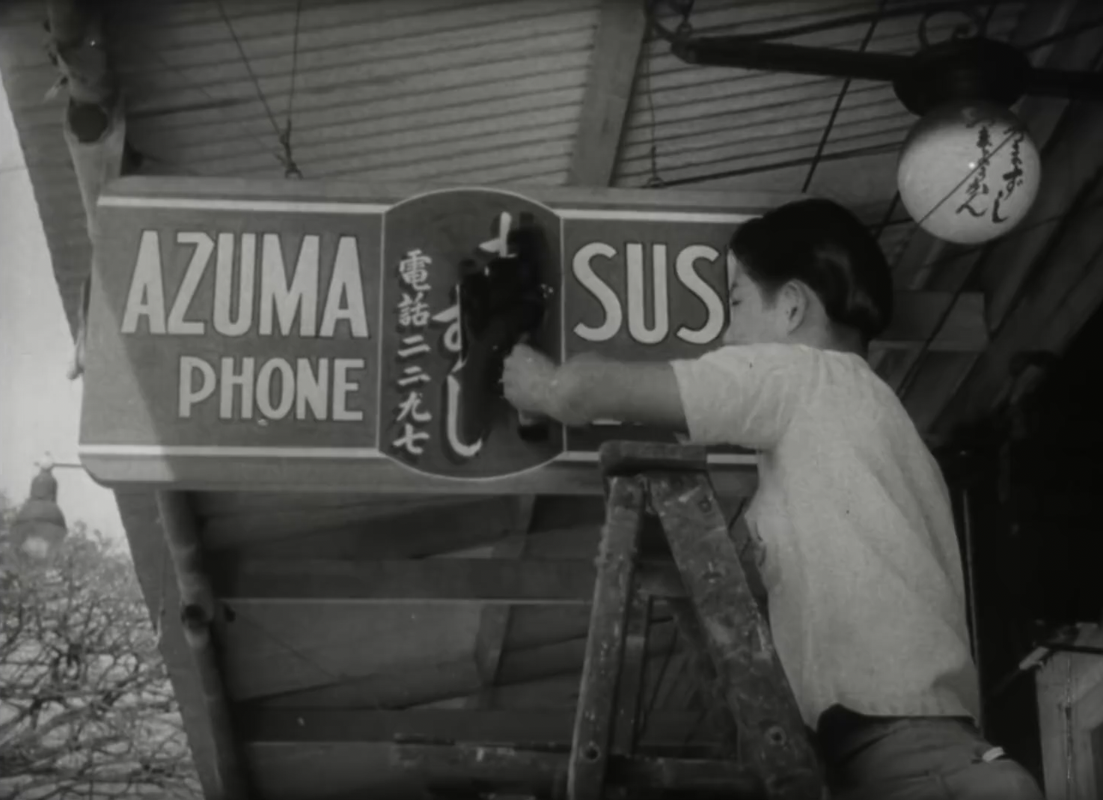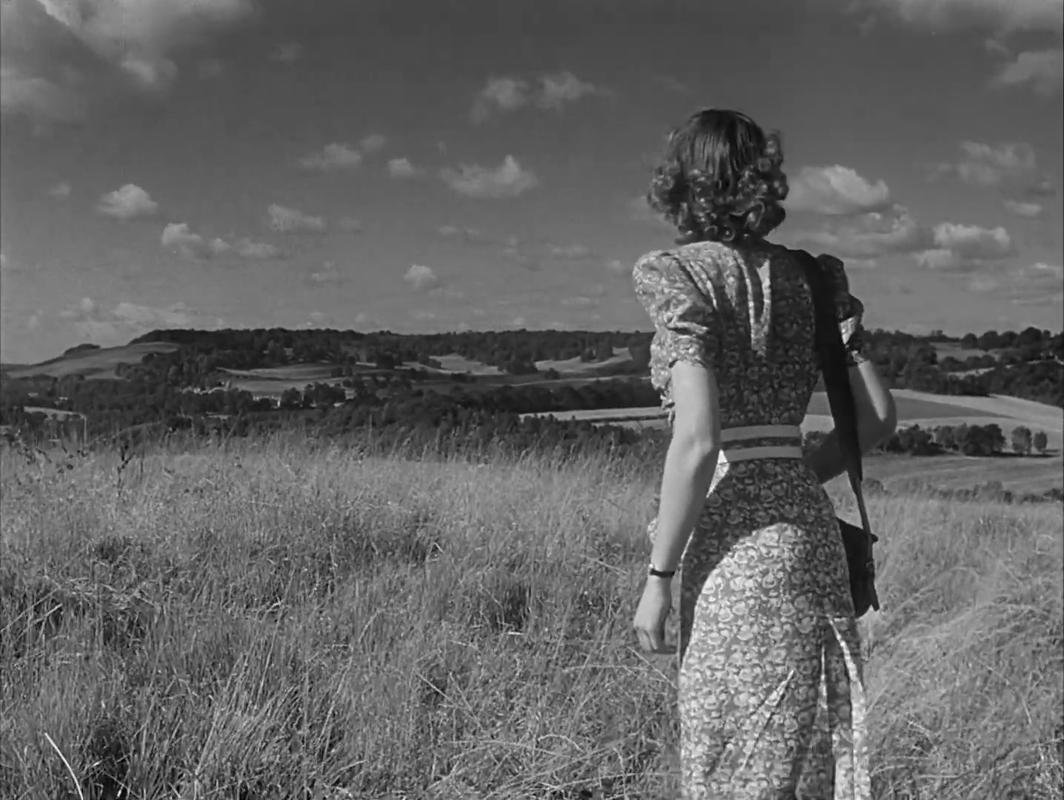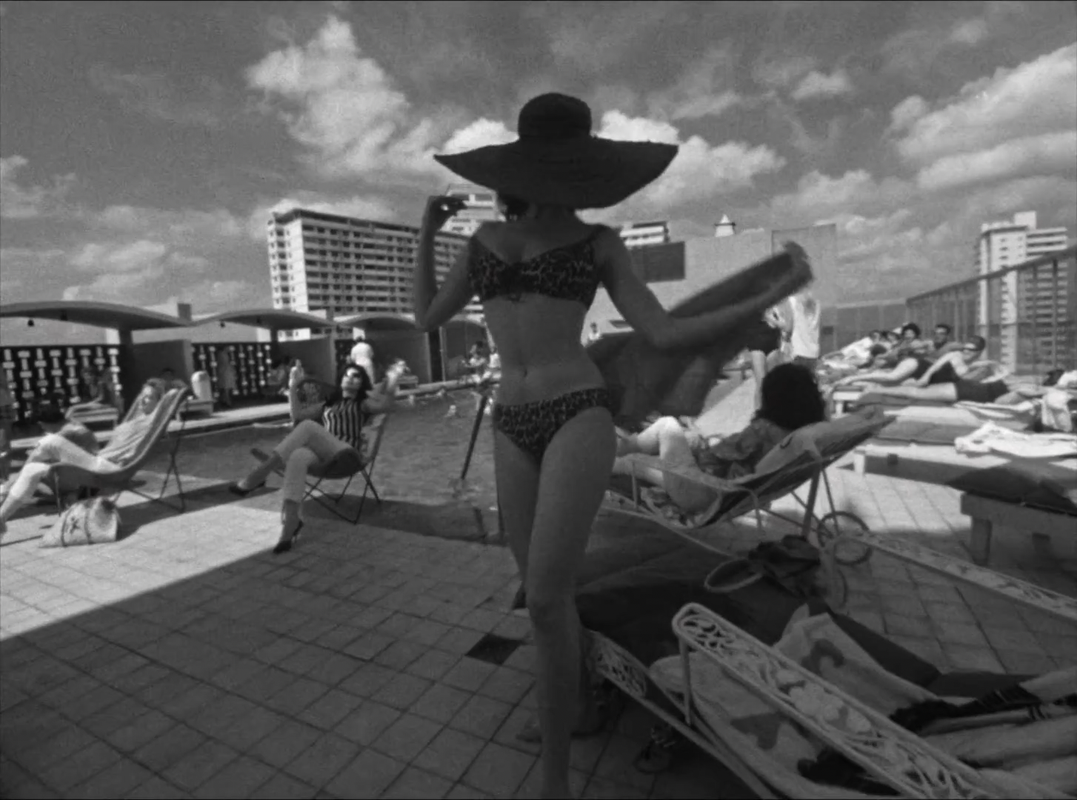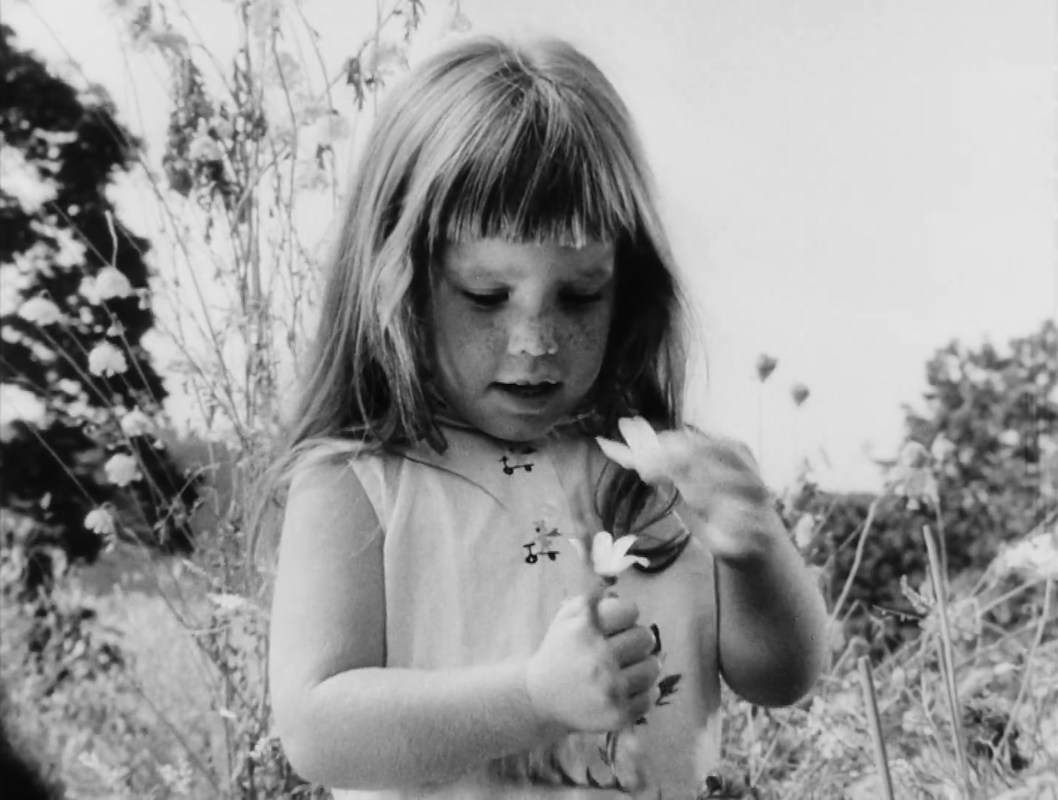“If that's Americanism, it's very hyphenated.”December 7th (John Ford + Gregg Toland, 1943)
Dec
7
1941

A Japanese person paints over the Japanese characters on their store's sign. AZUMA PHONE and SUS[HI obscured] can stay. DP: Gregg Toland.
– narrator
propaganda
“One… two… three… four… five… seven… six… six… eight… nine… nine…”Peace, little girl [Daisy / Daisy Girl] (Sidney Myers, 1964)
Nov
3
1964

Monique Corzilius aka Monique Cozy as the Daisy Girl. DP: Drummond Drury.
– Daisy Girl
“Well, there are more ways than one of getting close to your ancestors. Follow the old road, and as you walk, think of them and of the old England. They climbed Chillingbourne Hill, just as you. They sweated and paused for breath just as you did today. And when you see the bluebells in the spring and the wild thyme, and the broom and the heather, you're only seeing what their eyes saw. You ford the same rivers. The same birds are singing. When you lie flat on your back and rest, and watch the clouds sailing, as I often do, you're so close to those other people, that you can hear the thrumming of the hoofs of their horses, and the sound of the wheels on the road, and their laughter and talk, and the music of the instruments they carried. And when I turn the bend in the road, where they too saw the towers of Canterbury, I feel I've only to turn my head, to see them on the road behind me.”A Canterbury Tale (Michael Powell + Emeric Pressburger, 1944)
Aug
27

Alison (Sheila Sim) looking out over the rolling hills of Kent with the Canterbury Cathedral somewhere out there. DP: Erwin Hillier.
– Thomas Colpeper, JP
“I am Cuba. Why are you running away? You came here to have fun? Go ahead, have fun! Is this a happy picture? Don't avert your eyes. Look! I am Cuba. For you, I am the casino, the bar, the hotels. But the hands of these children and old people, are also me.”Soy Cuba [I Am Cuba] (Mikhail Kalatozov, 1964)
Jul
10

The rich and beautiful spend a lazy day at a grand rooftop pool. DP: Sergey Urusevskiy.
Someone in poolside vacation clothing*
– the voice of Cuba
* the Bales 2025 Film Challenge for July is, for unknown reasons, mostly not date-related and follows some sort of vacation narrative.
女篮五号 [Nü lan wu hao / Woman Basketball Player No. 5] (Jin Xie, 1957)
Apr
7
March Madness

Tense moments during the match. DPs: Shaofen Huang & Xilin Shen.
Basketball: the final day of March Madness
The first full-colour Chinese sports film and an example of how “state feminism” was promoted through popular media, often in opera but also in more humanist form.
“Shoulder to shoulder. The land is ours. Tomorrow is ours.”Броненосец Потёмкин [Bronenosets Potyomkin / Battleship Potemkin] (Sergei Eisenstein, 1925)
Jun
8
Bounty Day

A closeup of a sailor. DPs: Eduard Tisse & Vladimir Popov.
– sailor
“You're not dreaming.”A Canterbury Tale (Michael Powell + Emeric Pressburger, 1944)
May
7
National Paste Up Day

Thomas Colpeper, JP (Eric Portman) and Alison (Sheila Sim), her hair still wet from washing out the glue, observing her in a tall mirror. DP: Erwin Hillier.
In a strange other #England – in the village of Chillingbourne to be precise – a train pulls into the station. On board are several people on their way to #Canterbury.
– Thomas Colpeper, JP
When Alison disembarks, believing she arrived at the pilgrim's town, a stranger pours #glue in her hair. She's the eleventh, the policeman said. It's the glue man, the townsfolk know. Like the pilgrims of #Chaucer's poem, Alison and her fellow stranded travellers journey towards the closure of this mystifying case.
Аэлита [Aelita / Aelita: Queen of Mars] (Yakov Protazanov, 1924)
Apr
29
International Astronomy Day

Queen Aelita (Yuliya Solntseva) peering through her telescope. DPs: Emil Schünemann & Yuri Zhelyabuzhsky.
Like in Enrico Novelli's Un matrimonio interplanetario [A Marriage in the Moon] (1910), interplanetary romance blooms in Аэлита.
Through her #telescope, Queen Aelita spots engineer Los, a handsome Earth man, and he promptly travels to #Mars to be with her. There, Los uncovers an uprising by the Elders against his beloved queen that he vows to – in good proletarian fashion – stomp down.
Aelita*'s constructivist stage and costume design had an enormous influence on science fiction, as far as the late 20th century.
“Where rats turn up, they spread diseases and carry extermination into the land. They are cunning, cowardly and cruel, they travel in large packs, exactly the way the Jews infect the races of the world.”Der ewige Jude [The Eternal Jew] (Fritz Hippler, 1940)
Apr
4
World Rat Day

Nazi propaganda postcard advertising an exhibition in the library of the Deutsche Museum in Munich called Der ewige Jude: Große politische Schau (“The Eternal Jew: Great Political Exhibition”). The front of the card is a reproduction of the film poster. The card is dated 1937, which is at odds with the information in this blogpost. DPs: A. Endrejat, Anton Haffner, R. Hartmann, F.C. Heeve, Heinz Kluth, Erich Stoll & H. Winterfeld.
I took a long time considering what to nominate for today's topic. This is not an easy one. And frankly, barely qualifies as as film.
In the 1930s, three films (2 British, 1 American) portrayed Jews in a positive light, as victims of persecution through history. When in 1938 the Novemberpogrome took place in (Nazi-occupied) Germany (the term “Kristallnacht” is a horrible euphemism and I won't use it), media was not unanimously jubilant about it. Understanding that violence is not the way to popular consensus, plans were made to change people's thinking about the Jews, using widely available visual media.
In 1939, the faux #documentary Der ewige Jude, directed by the leader of Goebbels' #propaganda film department Fritz Hippler, started production. Scenes shot in Jewish ghettos in occupied Poland were intercut with real, but out-of-context documentary footage, giving it a false sense of authenticity./
– narrator
A recurring theme in Der ewige Jude is disease. Not merely to suggest “the Jew”'s unclean life and religion, but as a synonym of people as a vermin, a parasite to decent (read: Aryan) society. In a chilling demonstration of the Kuleshov Effect, footage of a large group of #rats coming out of a sewer is followed by a crowd of Jews in the Łódź Ghetto, filmed without their consent or knowledge of where this footage would end up.
Peace, little girl (1964)

March 21: #countdown to #NationalCountdownDay
Peace, little girl [Daisy aka Daisy Girl] (Sidney Myers, 1964)
One… two… three… four… five… seven… six… six… eight… nine… nine…
It was the #PoliticalAd campaign to end all political ad campaigns. Peace, little girl opens innocently enough with a little blonde girl, picking the petals of an ox-eye #daisy while counting. When the final petal's gone, the tone changes completely.
This deceptively simple propaganda film was made in support of Lyndon B. Johnson's 1964 presidential campaign by ad agency #DBB and media consultant Tony Schwartz. It was so effective and bleak in is insinuations that the Johnson campaign was forced to pull it after only one screening.
What fascinates me is the similarity with one particular scene from James Whale's #Frankenstein (1931). The Monster (#Karloff) meets a little girl who sits on the shore of a lake, picking daisies. He approaches her, and the girl, knowing the creature is a good man at heart, invites him to play a game with her involving them tossing the daisies into the lake.
The Monster (Boris Karloff) and little Maria (Marilyn Harris) playing with daisies on a beautiful day at the lake. DPs: Arthur Edeson & Paul Ivano.
Spoiler warning
When they run out of daisies, the Monster picks up the girl who to him is as pretty and innocent as a flower, and tosses her into the water.This scene was cut and considered lost until the 1980s. Could Tony Schwartz have been aware of that scene? He was at the right age to have seen the pre-code, pre-cut version.
#Bales2023FilmChallenge #SidneyMyers #LyndonBJohnson #ChrisSchenkel #MoniqueCorzilius #MoniqueCozy #RobertDryden #DrummondDrury #ShortFilm #war #peace #scaresploitation #flowers #propaganda #ColdWar #election #politics #USA #1960s ★★★★☆
